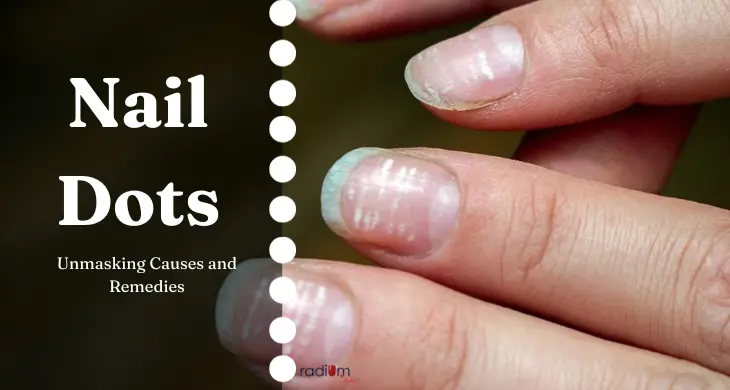Welcome to the world of nail care, where every little detail matters. Those seemingly innocuous white spots on your nails, often dismissed as minor imperfections, can reveal underlying issues that warrant your attention. In this comprehensive guide, we’ll dive deep into the world of nail dots, unmasking their causes and presenting effective remedies for a spotless, vibrant, and healthy nail canvas.
The Anatomy of Nail Dots:
Nail dots, those tiny, often inconspicuous specks that appear on our fingernails, may seem like a simple cosmetic concern, but understanding their anatomy is essential in deciphering their significance. These nail imperfections can vary in appearance, location, and texture, and each characteristic may provide valuable clues about their underlying causes.
Types of Nail Dots:
- Surface White Spots: These are the most common type of nail dots. They appear as small, milky-white dots on the surface of the nail and are often associated with minor trauma or nutritional deficiencies.
- Leukonychia Striata: These are vertical white lines or streaks that can extend from the base to the tip of the nail. They are usually benign and may result from trauma or mild fungal infections.
- Leukonychia Punctata: Characterized by small white spots that appear randomly on the nail plate, these spots are typically caused by minor trauma, allergic reactions, or fungal infections.
- Mees’ Lines: These are horizontal white lines that run parallel to the lunula (the crescent-shaped white area at the base of the nail). Mees’ lines may be indicative of more serious underlying conditions, such as severe illness or systemic diseases.
- Half and Half Nails: These nails exhibit two distinct colors, typically white at the top and brown or pink at the bottom.
Location and Appearance: The location and appearance of nail dots can vary. They may appear on one or more nails, affect the entire nail or just a portion of it, and can manifest as dots, lines, or streaks. The color of the dots may also differ, ranging from white to yellow or even brown.
Texture: The texture of nail dots can range from smooth to slightly raised or pitted. This variation in texture may provide additional clues about their underlying causes, especially when considering the possibility of fungal infections.
Causes Behind Nail Dots:
Nail dots, also known as leukonychia, can appear as white spots, lines, or streaks on your nails. While they’re often considered minor cosmetic issues, they can provide valuable insights into your overall health. Understanding the various causes behind nail dots is essential for addressing the root problem. Here are some common reasons why nail dots may develop:
- Trauma or Injury: Minor trauma to the nail matrix, such as banging your finger, can lead to the formation of white spots on the nail. These spots are usually harmless and will grow out as the nail does.
- Nutritional Deficiencies: A lack of essential nutrients, particularly zinc, calcium, and vitamin D, can result in white spots on the nails. Ensuring a balanced diet is crucial for maintaining healthy nails.
- Fungal Infections: Fungal infections, such as onychomycosis, can cause various nail abnormalities, including white spots. These spots may be accompanied by other symptoms like thickening, discoloration, or brittle nails.
- Allergies and Irritants: Contact dermatitis, caused by an allergic reaction or exposure to irritating substances like nail polish, nail hardeners, or nail polish removers, can lead to the formation of white spots on the nails.
- Medical Conditions: Certain underlying medical conditions can manifest as white spots on the nails. These may include psoriasis, eczema, alopecia areata, or thyroid disorders. Mees’ lines, horizontal white bands across the nails, can indicate severe illnesses or systemic diseases.
- Medications: Some medications can lead to changes in nail color and texture. Discuss any changes in your nails with your healthcare provider, especially if you suspect it may be related to medication you are taking.
DIY Remedies for Nail Dots:
Addressing nail dots at home can be effective for mild cases and those caused by minor issues like trauma or nutrient deficiencies. Here are some do-it-yourself (DIY) remedies and preventive measures to help you achieve healthier, spotless nails:
- Maintain a Balanced Diet: Ensure you’re getting a well-rounded diet rich in essential nutrients. Incorporate foods high in vitamins and minerals like zinc, calcium, and vitamin D to promote healthy nail growth.
- Hydration: Keep yourself well-hydrated to support overall nail health. Drinking plenty of water helps maintain nail moisture and strength.
- Nail Care Practices: Adopt good nail care practices, such as avoiding excessive filing or buffing, and refraining from using your nails as tools.
- Gentle Nail Polish Removers: If you use nail polish, choose acetone-free nail polish removers to reduce the risk of irritants that can contribute to nail dots.
- Protect Your Nails: Wear gloves when doing household chores or working with chemicals to prevent nail trauma and exposure to potential irritants.
- Biotin Supplements: Consult with a healthcare professional before taking supplements, but biotin is often recommended to promote healthy nails. It’s a water-soluble B-vitamin that can help strengthen nails.
- Tea Tree Oil for Fungal Infections: If your nail dots are caused by a fungal infection, you can try applying diluted tea tree oil to the affected area. Mix a few drops of tea tree oil with a carrier oil (like olive oil) and apply it to the affected nail daily.
- Garlic Paste for Fungal Infections: Some people find that garlic paste applied to the nails can help combat fungal infections. Crush a garlic clove, make a paste, and apply it to the affected area.
- Vitamin E Oil: Apply vitamin E oil to your nails and cuticles to keep them hydrated and healthy. This can help prevent trauma and keep your nails looking their best.
Remember that while these DIY remedies can be effective for some cases of nail dots, they may not work for more severe issues or conditions like Mees’ lines, which could indicate underlying health problems. If you’re concerned about your nail dots, or if they persist or worsen, it’s essential to consult with a dermatologist or healthcare professional for a proper diagnosis and tailored treatment.
Professional Treatments and Medical Interventions for Nail Dots:
When nail dots are persistent, severe, or indicate underlying health issues, it’s essential to seek professional guidance and consider medical interventions. Here are some of the options available:
- Dermatologist Consultation: If you have persistent or troubling nail dots, consult a dermatologist. They can perform a thorough examination and provide a diagnosis to determine the exact cause.
- Prescription Medications: In cases of fungal nail infections, a dermatologist may prescribe antifungal medications, either as topical creams, nail lacquers, or oral medications. These are essential for effectively treating fungal-related nail dots.
- Corticosteroid Creams: For nail dots related to allergic reactions or irritants, dermatologists may recommend corticosteroid creams or ointments to alleviate inflammation and promote healing.
- Oral Supplements: In situations where nail dots are linked to nutritional deficiencies, healthcare professionals may recommend oral supplements to correct the imbalance. These supplements typically include vitamins and minerals like zinc, calcium, and biotin.
- Phototherapy: Phototherapy, involving exposure to UV or laser light, can be used for specific nail disorders like psoriasis. It helps reduce inflammation and improve nail health.
- Surgery or Nail Removal: In severe cases of fungal infection or when other treatments fail, the removal of the affected nail may be necessary. A new, healthy nail will eventually grow in its place.
Preventing Nail Dots for Healthy Nails:
Maintaining healthy, beautiful nails involves a combination of proper nail care, a balanced diet, and overall health. Here are some essential tips to help prevent the development of nail dots and promote the well-being of your nails:
- Balanced Diet: Ensure your diet is rich in essential nutrients like biotin, calcium, zinc, and vitamin D. Foods such as leafy greens, nuts, dairy products, and lean proteins can support nail health.
- Hydration: Stay well-hydrated to maintain nail moisture and overall nail health.
- Gentle Nail Care: Handle your nails with care. Avoid excessive filing or buffing, and do not use your nails as tools for tasks like opening packages or scraping surfaces.
- Regular Trimming: Trim your nails regularly to maintain a proper nail length. Keeping your nails short can help reduce the risk of trauma and injury.
- Moisturize: Apply a moisturizing hand cream and cuticle oil to keep your nails and the surrounding skin hydrated. This prevents dryness and helps maintain nail flexibility.
- Protect Your Nails: Wear gloves when performing household chores or tasks that expose your nails to chemicals, harsh detergents, or other potential irritants.
- Safe Nail Products: Use nail care products that are gentle on your nails, including nail polish, nail polish removers, and nail hardeners. Opt for products that are acetone-free.
- Regular Inspections: Pay attention to your nails and keep an eye out for any changes in color, texture, or the appearance of nail dots.
- Maintain Nail Hygiene: Keep your nails clean by washing them regularly and using a nail brush to remove dirt and debris from under the nails.
- Avoid Overuse of Nail Extensions: Limit the use of acrylic or gel nail extensions, as prolonged use can weaken natural nails and make them more susceptible to damage.
- Professional Manicures: If you enjoy professional manicures, ensure that the salon follows proper sanitation practices to reduce the risk of fungal or bacterial infections.
- UV Protection: Protect your nails from excessive UV exposure. Extended sun exposure can weaken and discolor nails. Use sunscreen or wear gloves when in the sun for extended periods.
Frequently Asked Question:
1. What are nail dots, and why do they appear?
Nail dots are small white spots or lines on your nails. They can appear due to various reasons, including trauma, nutritional deficiencies, fungal infections, allergies, or underlying health conditions.
2.Are nail dots a sign of a serious health issue?
In some cases, nail dots can be a sign of underlying health conditions. Mees’ lines, for example, can indicate serious illnesses. Consult a healthcare professional if you are concerned.
3.How can I prevent nail dots?
You can prevent nail dots by maintaining a balanced diet, keeping your nails well-hydrated, practicing gentle nail care, and protecting your nails from trauma and irritants.
4.What is the role of diet in preventing nail dots?
A balanced diet rich in essential nutrients, including vitamins, minerals, and proteins, can help prevent nail dots by promoting healthy nail growth and strength.
5. Is there a natural remedy for fungal-related nail dots?
Tea tree oil and garlic paste are natural remedies that some people find effective for fungal-related nail dots. However, results may vary, and it’s crucial to consult a healthcare professional for persistent fungal infections.
Conclusion:
Nail dots may be small, but they can be significant indicators of your overall health and wellness. By understanding their causes and knowing how to effectively treat and prevent them, you can ensure that your nails remain blemish-free and vibrant. Get ready to unmask the secrets of nail dots and embark on a journey to nail perfection.

